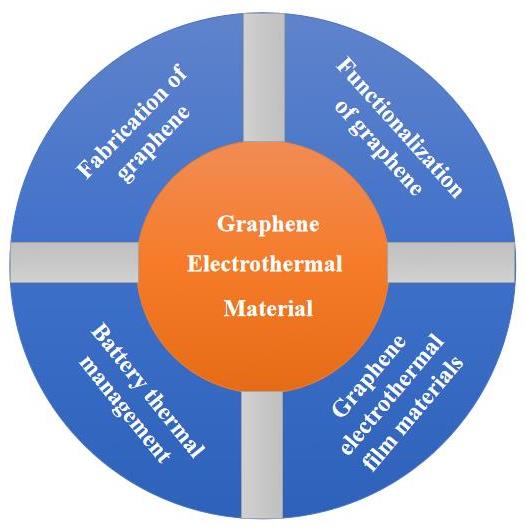Abbreviation (ISO4): Prog Chem
Editor in chief: Jincai ZHAO


Graphene Flexible Electrothermal Materials
Yangyang Cai, Lixia Wei, Yizhou Zhu, Lei Lu, Xiao Liu
Prog Chem ›› 2025, Vol. 37 ›› Issue (3) : 455-466.
Graphene Flexible Electrothermal Materials
Graphene is a two-dimensional nanomaterial with ultra-high thermal conductivity, which is widely used in the field of electric heating. By analyzing the research progress of graphene and its flexible electrothermal (membrane) materials, the preparation methods of graphene of different sizes and the effect of functional modification on the thermal conductivity of graphene are introduced. The applications of graphene flexible electric heating (film) materials in the fields of deicing and anti-fogging, wearable clothing and low-temperature battery thermal management are summarized. In the future, it is still necessary to break through the technical problems of the preparation process of graphene and its flexible heating (film) materials and the integration of heating elements.
1 Introduction
2 Preparation and modification of graphene materials
2.1 Small flake graphene
2.2 Large flake graphene
2.3 Functionalization of graphene
3 Graphene electrothermal composite materials
3.1 Graphene resin based materials
3.2 Graphene electrothermal film materials
4 Application of graphene electrothermal film
4.1 Defrosting and anti-fog
4.2 Wearable heating suit
4.3 Battery thermal management
4.4 Smart actuator
5 Conclusion and outlook

graphene / composite membrane material / thermal conductivity / functional modification
| [1] |
|
| [2] |
|
| [3] |
|
| [4] |
|
| [5] |
|
| [6] |
|
| [7] |
|
| [8] |
|
| [9] |
|
| [10] |
|
| [11] |
|
| [12] |
|
| [13] |
|
| [14] |
|
| [15] |
|
| [16] |
|
| [17] |
|
| [18] |
|
| [19] |
|
| [20] |
|
| [21] |
|
| [22] |
|
| [23] |
|
| [24] |
|
| [25] |
|
| [26] |
|
| [27] |
|
| [28] |
|
| [29] |
|
| [30] |
(何新民, 张婷, 陈飞, 蒋俊. 化学进展, 2018, 30(4): 439.).
|
| [31] |
|
| [32] |
|
| [33] |
|
| [34] |
|
| [35] |
|
| [36] |
|
| [37] |
|
| [38] |
|
| [39] |
|
| [40] |
|
| [41] |
|
| [42] |
|
| [43] |
|
| [44] |
|
| [45] |
|
| [46] |
|
| [47] |
|
| [48] |
|
| [49] |
|
| [50] |
|
| [51] |
|
| [52] |
|
| [53] |
|
| [54] |
|
| [55] |
|
| [56] |
|
| [57] |
|
| [58] |
|
| [59] |
|
| [60] |
|
| [61] |
|
| [62] |
|
| [63] |
|
| [64] |
|
| [65] |
|
| [66] |
|
| [67] |
|
| [68] |
(陈宇, 张代军, 李军, 温嘉轩, 陈祥宝. 材料工程, 2021, 49(5): 82.).
|
| [69] |
|
| [70] |
|
| [71] |
|
| [72] |
|
| [73] |
|
| [74] |
|
| [75] |
|
| [76] |
(周醒, 胡斌, 肖文强, 姜豪, 张莉君, 王正君, 蔺海兰, 卞军, 赵新为. 材料研究学报, 2017, 31(11): 874.).
|
| [77] |
|
| [78] |
|
| [79] |
|
| [80] |
|
| [81] |
|
| [82] |
|
| [83] |
|
| [84] |
|
| [85] |
|
| [86] |
|
| [87] |
|
| [88] |
|
| [89] |
|
| [90] |
(宋雨晴. 中国科学技术大学博士论文, 2019.
|
| [91] |
|
| [92] |
|
| [93] |
|
| [94] |
|
| [95] |
(王萍萍, 袁雪, 陈松, 刘书奇, 刘海洲, 刘岚. 功能材料, 2018, 49(2): 2214.).
|
| [96] |
|
| [97] |
|
| [98] |
|
| [99] |
|
| [100] |
|
| [101] |
|
| [102] |
|
| [103] |
|
| [104] |
|
| [105] |
(钱梦霜. 南京航空航天大学硕士论文, 2018.).
|
| [106] |
|
| [107] |
|
| [108] |
|
| [109] |
|
| [110] |
|
| [111] |
|
| [112] |
|
| [113] |
|
| [114] |
|
| [115] |
|
| [116] |
|
| [117] |
|
| [118] |
|
| [119] |
(刘阳坤. 哈尔滨工业大学硕士论文, 2019.).
|
| [120] |
|
| [121] |
|
| [122] |
|
| [123] |
|
| [124] |
|
| [125] |
|
| [126] |
|
| [127] |
|
| [128] |
|
| [129] |
|
| [130] |
|
/
| 〈 |
|
〉 |